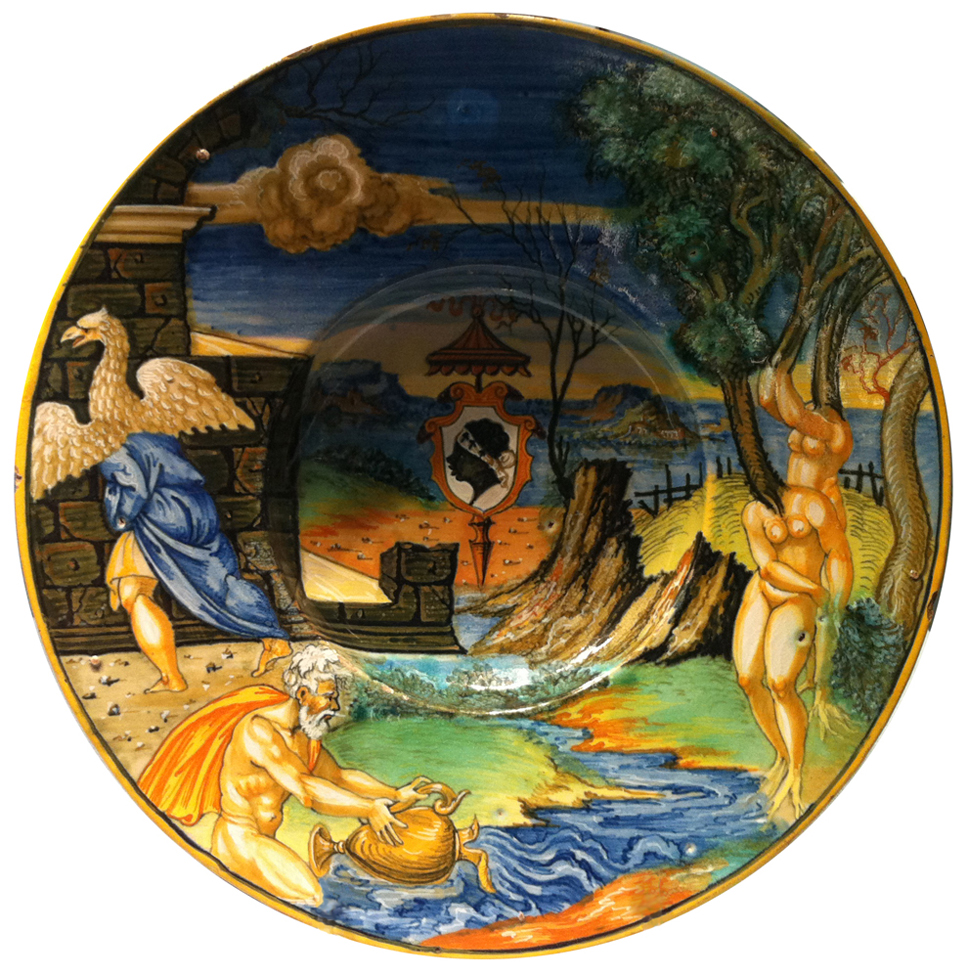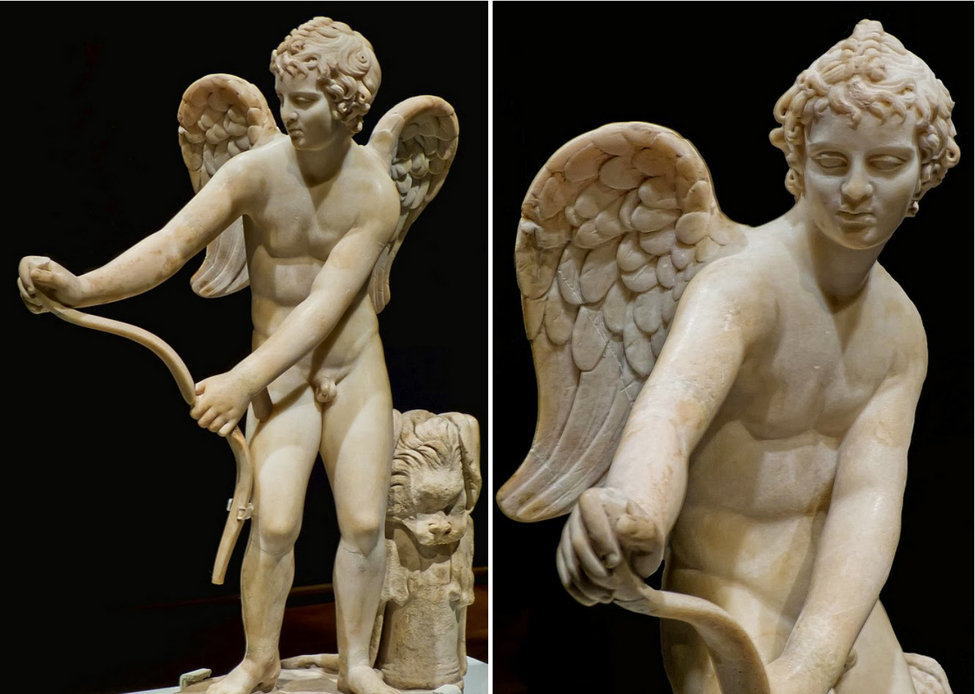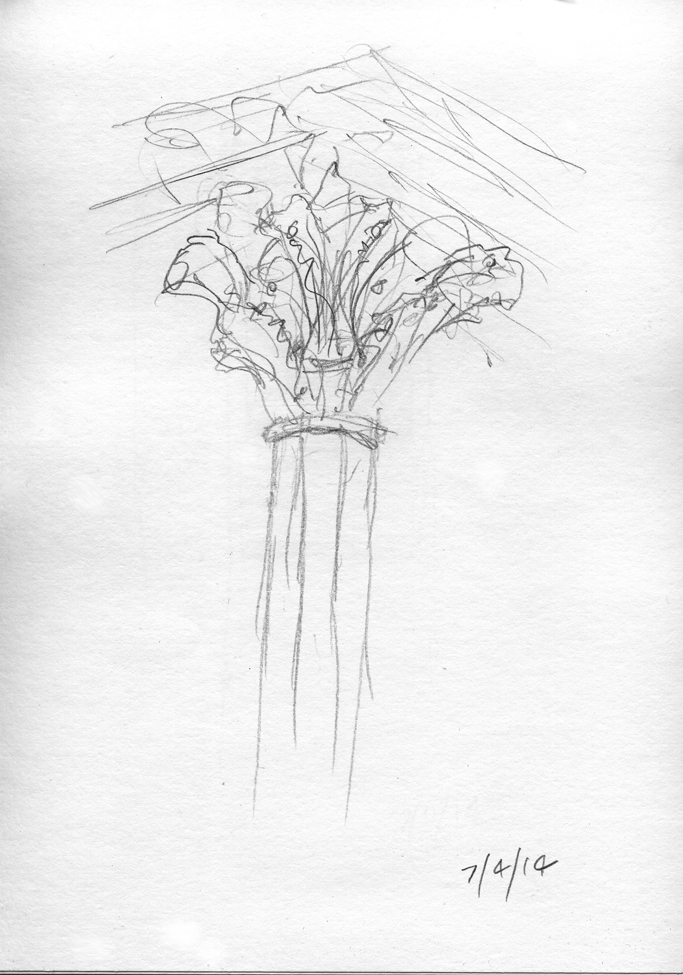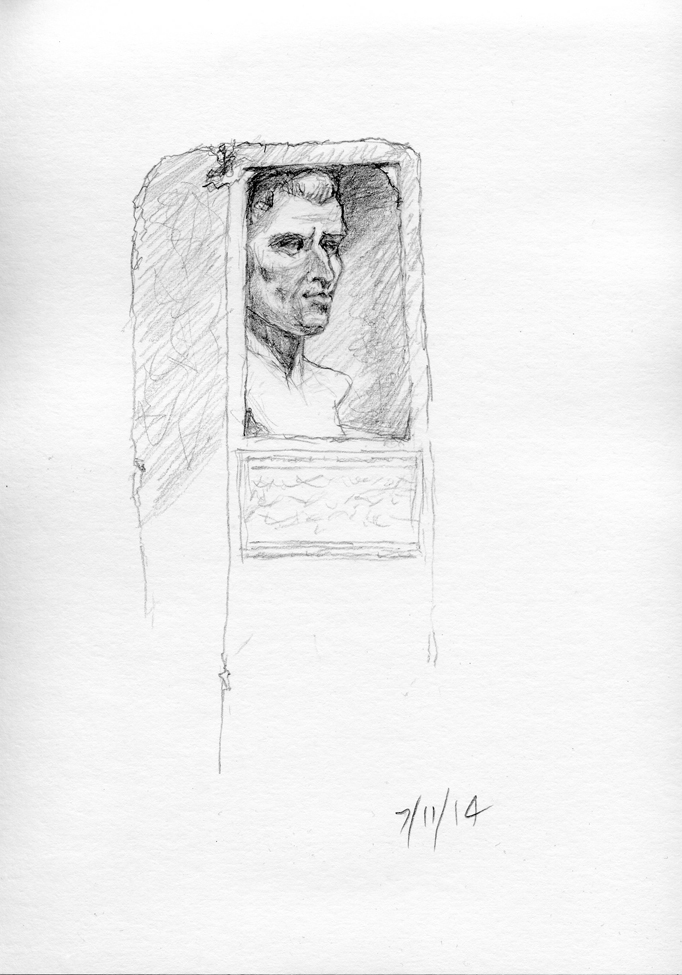L
The final monument to added to the Forum Romanum is a single, elegantly proportioned Corinthian column standing forty-four feet tall on its marble plinth and erected in 608. Its inscription, uncovered in 1813, reads: “To the best, most clement and pious ruler, our lord Phocas the perpetual emperor, crowned by God, the forever august triumphator, did Smaragdus, former praepositus sacri palatii and patricius and Exarch of Italy, devoted to His Clemency for the innumerable benefactions of His Piousness and for the peace acquired for Italy and its freedom preserved, this statue of His Majesty, blinking from the splendor of gold here on this tallest column for his eternal glory erect and dedicate, on the first day of the month of August, in the eleventh indiction in the fifth year after the consulate of His Piousness.” The column itself served as the pedestal for a gilded statue of Phocas himself, then the Eastern Emperor. Rome may be eternal, but Phocas was not. Assassinated two years later, his statues were everywhere toppled.
But the column remained and remains. It can be seen in numerous vedute and Grand Tour studies from the sixteenth to early nineteenth century, often set against the backdrop of the Arch of Septimus Severus. In many of the images one can clearly see how the silt and debris of centuries rose over the plinth and over the base of the column, and nearly filled in the opening of the Arch. In these renderings one finds small human figures set amidst the monumental stonework: tourists, vagabonds, and, fairly consistently, wheelwrights, who seem to have turned the forum into something of an informal manufactory. Here and there, dogs disport, and cows graze on the slopes of the Capitoline Hill.
While visiting the moon in 1971, Alan Shepard drove two golf balls into the non-atmosphere. Where are they now?
…blinking from the splendor of gold here on this tallest column for his eternal glory…
Jabès: There would be the event. However, does the event exist? There is the white space before the event and the white space after the event. But who could tell them apart? So the event is perhaps the unexpected shattering of the white space within the infinite space of the book. [Book of Margins, translated by Rosemary Waldrop. Chicago: The University of Chicago Press, 1993.]
New York City summer ’14: vanity : confusion : alternating perfunctory and sincere attempts at good will.
Moongolf, mon amour.
We have had many global events from Diana’s death to the World Cup, or even violent and real events from wars to genocides. But not one global symbolic event, that is an event not only with global repercussions, but one that questions the very process of globalization. All through the stagnant ‘90s, there has been “la grève des événements” (literally “an events strike,” translated from a phrase of the Argentine writer Macedonio Fernandez). Well, the strike is off. We are even facing, with the World Trade Center & New York hits, the absolute event, the “mother” of events, the pure event which is the essence of all the events that never happened.
So wrote Baudrillard in Le Monde, 11/2/01, trans. Rachel Bloul.
The event: Phaethon, son of Helios, tries to drive his father’s sun chariot, loses control of horses and swoops toward the ground. Seeing that the earth is about to be scorched, Zeus looses a thunderbolt, and kills him.
Mercifully, the gods turn his grieving friend Cygnus into a swan, and his distraught sisters are transformed into poplar trees. As ever, then, the event takes on plumage. And it ramifies. To the point where in Italy, when, in the “Renaissance,” such myths became popular again, a painter depicted the aftermath on a plate intended for a nobleman’s table. Some time in the 20th Century, a banker and art collector bought the plate, and, shortly after his death in 1969, the foundation he had set up donated it, along with myriad other objects to a new “wing” – those feathers again – at the Metropolitan Museum. And you took a picture of the picture of the aftermath of the event, and posted it on your blog.
And yet it ramifies, como las ramas de las hermanas de Phaethon.
Plato, for whom writing is both “remedy” and “poison,” a “poison-remedy,” considers it suspect, but his suspicion is in writing. Says Jabès, op. cit.
And what of Icarus in Breughel’s painting? He, like Phaethon on the plate devoted to the aftermath of perishment, is nowhere to be seen. We conj(ect)ure his presence from a slight disturbance of water, and oh, yes, that wee pair of nearly vanished legs. Yet still, in all the action of the painting – a painting par excellence of forces at play – the visible evidence of his submergence is hardly more striking than a line of foam, nothing but the visible e-mergence of transformations that remain as invisible as the deeply buried movements of a breaking wave of water. Does the event exist? And if it does, than how, and of what is it constituted? And again, the heat of the sun, melting wax, loosing feathers, scorching earth. And baking the tears of the poplar sisters, who, arrayed along the banks of the Po, now weep amber to adorn the joyous brides of Rome.
Stepping down to the trough.
Sunday midday and the checkout lines at Trader Joe’s wend serpentine through the store: a human ribbon of hipsters of various ages and stages of degradation. Here and there, a bestrollered infant shrieks inconsolably. You could ruin your vision trying to read the illegible tattoos. Over the sound system, Bowie’s hyper-articulated “Fame,” segues into John Kay growling born to be wild.
What Lennon didn’t sing: Imagine there’s no classes.
Poetry is a craft by means of which the poet arranges in order premises that produce an image in the mind and knits together arguments that lead to a conclusion in such a way that makes the meaning of an insignificant thing significant and a significant thing insignificant, and displays a beautiful thing in an ugly robe and an ugly thing in gorgeous raiment. By means of such ambiguousness, the poet stirs up the irascible and concupiscent faculties so that people… cause great affairs in the order of the world.
Said, Platonic-ally, Nizam Arudi of Samarqand, in his discourse on poets, some nine hundred solar revolutions ago. [My gratitude to Quitman Marshall and his remarkable collection You Were Born One Time. Greenville, SC: Ninety-six Press, 2014]
Illusionism and its discontents.
Appeles:
the finest line
Rupture, suture
seem
seen
seamless
The Market and The Event radically and mutually leverage one another.
Even(t) within the Event: Zizou and the World butt.
Why is this Buddha smiling?
Eros is not Event.
Eros is non-negotiable.
In the Mustard Seed Garden of the Finzi-Continis.
For Piny and Quintillian both, the story ended with Lysippos, who purportedly said that, unlike his predecessors, he did not represent people as they are, rather as they appear to be.
But the bow, once drawn, demands release. Yet often the wait is a long one, longer than Danae’s nights of frustrated fruition. For the cycle dictates another and another great discarding of nature on behalf of God. Converted, the Emperor Justinian and his posse of the saved do everything the can to stare us down onto our knees (in the astonishing 6th century mosaic in church of San Vitale, Ravenna – I have written of the icon’s power elsewhere).
“The Byzantine icon is not conceived as free ‘fiction,’; it somehow partakes of the nature of a Platonic truth,” says Gombrich. Still, the golden rain, unnoticed and unheard, condenses and must, one day, shower down.
Parallel streets flank the Gare Montparnasse: Rue de l’arrivée and Rue du depart. Immediately in front of the station lies the Place du 18 Juin 1940 – the name commemorating De Gaulle’s first radio broadcast from England, appealing for French resistance to the Nazi occupation and the Vichy government. Behind the station, a broad delta of tracks, narrowing down to a pair, as they proceed southwest.
The illusion can, in some sense, never be fixed. It eludes the iconic. But it real? And if so, how many times?
Beneath narcissism, nihilism.
Li-Fire symbolizes the clarity of consciousness and depth of feeling that is associated with the human mind and the human heart. In the center of the trigram, the broken yin line represents receptiveness and openness that is characteristic of a clear and conscious mind. However it can also represent the mental conditioning and circular thinking that insinuates itself into the heart and mind making them cling and attend to the external and superficial. Says Bisio in Decoding the Dao.
Writing of The Event in The Silent Transformations, Jullien observes that …the event immediately plays at being an event … because the event ‘consumes’ itself. It consumes itself in order to put a little intensity into our lives, and we even revel in it. The pathos is immediately orchestrated, displayed and exhausted. We give ourselves the convenient impression, even the comfortable justification, that we are generously in tune with the world, although it is a matter only of an easy opportunity to shake off our apathy and finally have something upon which to cling,to deal with, and to speak about.
The sunflower does not turn toward the bonfire.
A triage grows in Brooklyn. And hardly there alone.
How is meaning carried?
Jane Mary Todd, the translator of François Jullien’s The Great Image Has No Form, or On the Nonobject Through Painting [Chicago: University of Chicago Press, 2009] has this to say in her “Translator’s Note”:
The expression I translate as “foundation-fount” is fond(s),which combines two French terms, each with a wide range of meanings. Fond means, among other things, “bottom” and “foundation”; it is also contrasted to forme in the form/content binary, and to figure in figure/ground. Au fond or dans le fond means “fundamentally” and au found may also mean “deep down.” Une boîte à double fond is a box with a false bottom. The fonds de bouteille are the dregs at the bottom of a bottle; fonds de café are coffee grounds. Grands fonds are the ocean depths.
Fonds, in addition to being the plural form of fond, is a singular noun whose primary meaning is “fund” or “capital.” Fonds de terre is real estate, fonds publics government stocks. A library collection is also called a fonds, and the term can be used more generally to mean “source” or “resource.” Although the English “fund” once meant “font” and still means “a supply of material resources,” “a reserve of intangible resources” (Webster’s Third New International Dictionary), its connotations are too monetary for this context. Jullien defines fond(s) as “à la fois found et source, fons et fundus” (both ground and source, source and ground; and often pairs the term fonds with words alluding to its liquidity: amont, résorber, irriguer, découler (upstream, resorb, irrigate, flow). Hence “fount,” which Webster’s defines as “a reservoir for liquids” and, most pertinent in this context, as “something that resembles a spring or reservoir: source,” is particularly felicitous.
The French word esprit also posed some difficulties. In addition to meaning “spirit” as we understand it, esprit signifies “mind.” The adjective spirituel refers both to religious or supernatural matters and to ideas or mental processes. Jullien’s use of the term veers now toward “soul,” now toward “agency of thought.” At times I could not avoid using “mind,” but I translated the term as “spirit” whenever possible, even in some situations where the word “mind” would be the more expected choice. This may constitute a point of resistance in understanding the translation, since speakers of English do not ordinarily think of the “spirit” as having the capacity for thought, nor do we consider ideas as belonging to the realm of spirit (as opposed to the realm of matter). [She notes that one of the obsolete meanings of “spirits” is “mental constitution … mental powers; intellect.”] But such is in fact the French view. Hence it is not entirely accurate to say that esprit means both “spirit” and “mind”; rather the capacity for thought is understood in French to belong to the “spirit dimension.” As a result, it is more jarring to attribute an esprit to a landscape than to attribute it a “spirit.”
A similar, though less extreme, problem arose with le vide. The French term means “emptiness,” in opposition to le plein, “fullness,” but it is also the word used to translate “void” or “vacuum” as that concept is developed in early Greek thought. Since Jullien’s discussion of Chinese art theory and of Greek philosophy is conducted in French, his text gives the impression that Aristotle and the Laozi are somehow talking about the same thing. The impression is lost in English (the Laozi speaks of “emptiness” or “empty spaces,” Aristotle of “the void”), though of course the two concepts are related.
I hope that readers will see these difficulties not as a particular shortcoming of my translation but as an opportunity to meditate further on translation issues generally, as they arise even within what Jullien terms “the great European language.”
And we also have “font” or “fount” as referring both to a complete set of metal type and to the style of the lettering itself, e.g. Cochin is a very elegant serif font…
Events are the white caps of foam in the great turning sea.
And the slow, inexorable maturation of drama into dharma.



